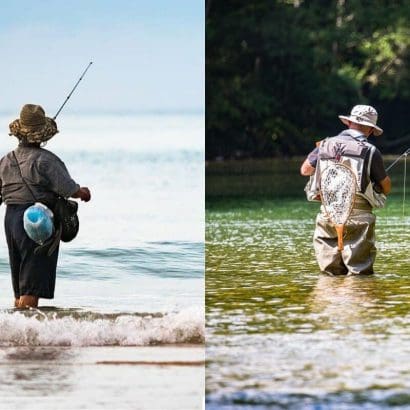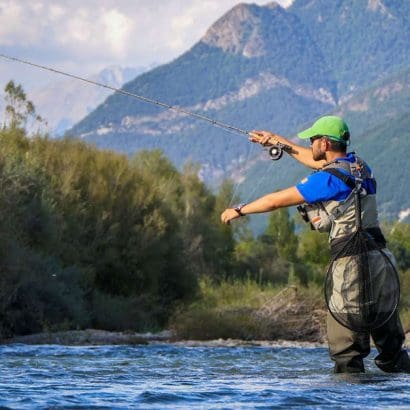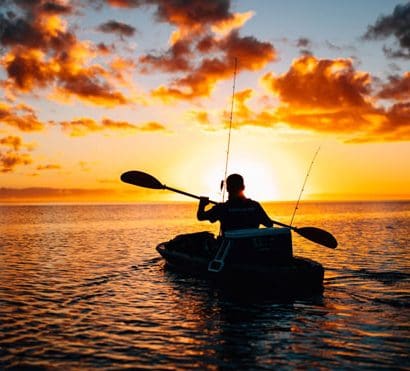
Embarking on the serene waters with nothing but a kayak and a fishing rod is more than just a hobby—it’s an exhilarating adventure that opens up a world of angling possibilities. Welcome to the realm of kayak fishing, where the simplicity of a paddle-powered vessel transforms fishing into an art form. Whether you’re a novice or a seasoned angler, the art of kayak fishing offers an accessible and immersive experience for all ages.
Picture yourself gliding silently across calm waters, surrounded by the beauty of nature, as you hone your fishing skills from the unique vantage point of a kayak. In this guide, we’ll explore the essential “Tips for Kayak Fishing”.
Contents
Choosing the Right Kayak.🐟
When it comes to Tips for Kayak Fishing, the first and crucial step is selecting the right kayak. This decision shapes your entire fishing experience, influencing your comfort, stability, and overall enjoyment on the water. Let’s dive into the essential factors to consider, ensuring you make an informed choice that suits your angling aspirations.
Types of Kayaks for Fishing.
There’s no one-size-fits-all kayak for anglers, so understanding the various types is key. Sit-on-top kayaks are beginner-friendly, providing stability and easy access, making them a great choice for families and those new to the craft. On the other hand, sit-inside kayaks offer better protection from splashes and colder waters, making them suitable for diverse environments.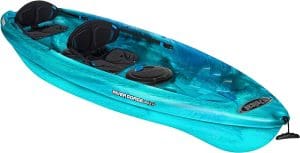
Size Matters.
The size of your kayak matters more than you might think. Opt for a kayak that matches your body size and weight for optimal comfort. Smaller kayaks offer agility and ease of maneuvering, while larger ones provide more stability, ideal for those who prefer a relaxed fishing experience.
Balancing Stability and Maneuverability.
Strike a balance between stability and maneuverability based on your fishing preferences. Wide kayaks offer enhanced stability, making them ideal for beginners and families. Meanwhile, narrow kayaks provide better maneuverability, perfect for experienced anglers chasing elusive fish in intricate waterways.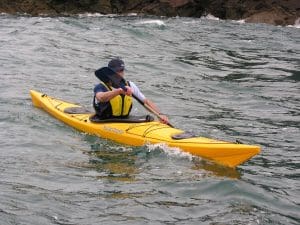
Freshwater Fishing vs. Saltwater Fishing.
Consider where you plan to cast your line – in freshwater or saltwater. Freshwater kayaks are often lighter and more agile, perfect for navigating rivers and lakes. On the flip side, saltwater kayaks are designed to handle the harsher conditions of the ocean, with features like corrosion-resistant materials and enhanced stability against waves.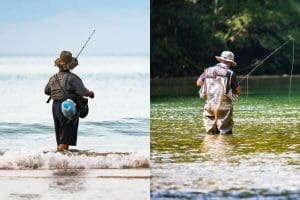
Features to Look For.
When exploring kayak options, keep an eye out for specific features that cater to fishing. Rod holders, built-in storage, and adjustable footrests are invaluable additions for anglers. These elements contribute to a seamless fishing experience, allowing you to focus on the thrill of the catch.
Transport and Storage Considerations.
Practicality extends beyond the water, especially when dealing with transport and storage. Ensure your chosen kayak is manageable for transportation – whether it’s on the roof of your car or in the bed of a truck. Collapsible or inflatable options might be worth considering if space is a concern.
Essential Gear and Tackle.🐟
When delving into the world of kayak fishing, having the right gear and tackle is as crucial as finding the perfect fishing spot. In this section of “Tips for Kayak Fishing,” we’ll explore the must-have equipment to ensure a successful and enjoyable angling experience for anglers of all ages.
Fishing Rods and Reels.
Boldly embark on your kayak fishing journey with the right fishing rod and reel combo. For beginners, consider a versatile spinning reel paired with a medium-action rod, allowing for a wide range of fishing techniques. Ultralight setups are excellent for children or those seeking a more delicate touch in freshwater.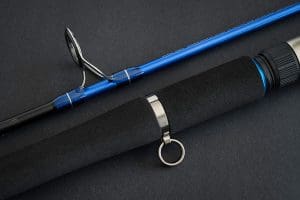
Tackling the Bait Dilemma.
Navigating the vast world of bait options can be overwhelming, but fear not! For a well-rounded approach, pack a variety of baits such as soft plastics, crankbaits, and live bait. Tailor your selection to the specific fish species you’re targeting and the prevailing conditions. Don’t forget to bring a sturdy tackle box to keep your arsenal organized.
Safety Essentials.
Ensuring your safety on the water is paramount. Equip yourself with a life jacket designed for kayaking, providing both buoyancy and freedom of movement. In the unpredictable waters, safety should never take a backseat. Additionally, pack a first aid kit with essentials like bandages, antiseptic wipes, and any necessary personal medications.
Selecting the right fishing line can significantly impact your success. For kayak fishing, braided lines are a popular choice due to their strength and minimal stretch. Fluorocarbon lines, with their near-invisibility underwater, are ideal for more finicky fish. Experiment with different lines to find what suits your fishing style.
Gear for All Seasons.
Equip yourself for success in all seasons. Invest in quality rain gear and dress in layers to stay comfortable during unpredictable weather. In warmer climates, a wide-brimmed hat and sunscreen are essential. For colder conditions, thermal layers and waterproof clothing will keep you warm and dry.
Seafood Dishes in Spanish Gastronomy A Culinary Connection.🐟
Beyond the thrill of the catch, kayak fishing often leads to a delicious culinary reward. Connect your fishing adventure with the rich tradition of seafood dishes in Spanish gastronomy. Explore recipes featuring the freshest catches, from paella loaded with seafood to simple grilled fish seasoned with Mediterranean flair.
A Sustainable Approach to Angling.
As stewards of the environment, responsible angling is crucial. Familiarize yourself with local fishing regulations, practice catch-and-release when appropriate, and dispose of trash responsibly. By adopting a sustainable approach, you contribute to the preservation of aquatic ecosystems for future generations.
Safety Measures on the Water.🐟
When it comes to enjoying the tranquility of kayak fishing, prioritizing safety is paramount. In this section on “Safety Measures on the Water,” we’ll explore essential precautions to make your fishing adventure not only exciting but also secure for anglers of all ages.
Familiarize Yourself with Your Kayak.
Before setting sail, familiarize yourself with your kayak. Take note of its features, including stability, buoyancy, and the location of important items like paddle holders. This knowledge ensures you can navigate your kayak with confidence, reducing the risk of accidents on the water.
Weather Awareness.
Stay on the right side of Mother Nature by keeping an eye on the weather forecast. Unpredictable weather can quickly turn a calm day into a challenging one. Check for conditions like wind speed, storms, or sudden temperature changes, and plan your fishing trips accordingly.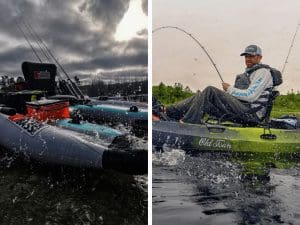
Communication Essentials.
Stay connected on the water by bringing communication essentials. A whistle is a simple yet effective tool for signaling others, and a waterproof communication device can be a lifesaver in emergencies. Make sure your device is fully charged and accessible in case you need assistance.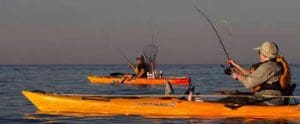
Buddy System.
Embrace the buddy system – it’s not just a saying. Having a fishing companion enhances both the enjoyment and safety of your kayak fishing expedition. In case of an emergency, having someone nearby can make all the difference. Share your plans with someone on land, including your expected return time.
Navigation Lights for Night Fishing.
For those venturing into the waters after sunset, navigation lights are non-negotiable. Ensure your kayak is equipped with proper lights, making you visible to other boaters and ensuring a safer experience during night fishing. Always check local regulations regarding night fishing equipment.
Emergency Preparedness.
No one plans for emergencies, but being prepared can make a significant difference. Pack a compact first aid kit, a multi-tool, and a bailer or bilge pump to handle unexpected water accumulation. Knowing basic water rescue techniques is equally important.
Mastering Paddling Techniques.🐟
In the realm of kayak fishing, your paddle is not just a means of transportation; it’s your tool for navigating the waters and reaching those prime fishing spots. In this segment on “Mastering Paddling Techniques,” we’ll delve into practical tips suitable for anglers of all ages to ensure a smooth and enjoyable kayaking experience.
Embracing the Basics of Paddling.
Before embarking on your kayak fishing adventure, familiarize yourself with the basics of paddling. Hold your paddle with a firm yet relaxed grip, ensuring the concave side is facing you. Position your hands shoulder-width apart for optimal control. This foundational knowledge sets the stage for more advanced techniques.
Efficient Forward Stroke.
The efficient forward stroke is your powerhouse for moving ahead. Dip the blade fully into the water near your toes and pull it back alongside the kayak, keeping it close to the boat for a straighter trajectory. Engage your torso muscles for added power, allowing you to cover more water with less effort.
Mastering the Art of Turning.
Navigate the waters with grace using the sweep stroke for turning. Extend your paddle away from the kayak and arc it towards the stern in a wide, sweeping motion. This technique helps you turn smoothly without losing momentum. Practice this skill in open water to enhance your maneuverability.
When faced with tight spots or obstacles, the draw stroke comes to the rescue. This technique involves pulling water towards the side of the kayak to bring yourself closer to an object or change your direction. Mastering the draw stroke enhances your ability to navigate through challenging waters effortlessly.
Staying on Course – The J-Stroke.
Maintain a straight course without constantly switching sides by mastering the J-stroke. After the regular forward stroke, twist your wrist to turn the paddle blade outward, forming a J shape at the end of the stroke. This technique minimizes the need for corrections, allowing for efficient and straightforward paddling.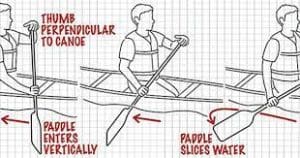
Balancing Act – The Low Brace Stroke.
For stability and balance, practice the low brace stroke. If you feel your kayak tilting, use this stroke by placing the backside of the paddle blade on the water surface and applying gentle downward pressure. It acts as a supportive brace, preventing you from tipping over in choppy waters.
Perfecting Your Rhythm – Practice and Patience.
Like any skill, mastering paddling techniques requires practice and patience. Head to calm waters initially, gradually progressing to more challenging conditions as you gain confidence. Regular practice not only refines your strokes but also builds muscle memory, making you a more proficient paddler over time.
Location and Seasonal Considerations.🐟
In the captivating world of kayak fishing, the success of your expedition often hinges on choosing the right location and timing your adventure with the seasons. In this section on “Location and Seasonal Considerations,” we’ll unravel the secrets to selecting the ideal fishing spot and making the most of each season, catering to anglers of all ages.
Unveiling the Ideal Fishing Spots.
Before setting sail on your kayak, the first puzzle piece to consider is choosing the right fishing spot. Lakes, rivers, and coastal areas each offer unique opportunities. Opt for spots with underwater structures like submerged rocks or vegetation, as they attract various fish species seeking refuge and prey.
Freshwater vs. Saltwater Fishing – Know the Difference.
Understanding the difference between freshwater and saltwater fishing is crucial. Freshwater bodies like lakes and rivers are home to species like bass and trout, while saltwater environments host fish such as snapper and sea bass. Adapt your gear and techniques based on the type of water you’ll be exploring.
The Impact of Seasonal Changes.
Seasonal changes significantly influence fish behavior. In spring, fish are often more active and move to shallower waters for spawning. Summer brings warmth, pushing them to deeper, cooler areas. Fall marks the time for feeding to prepare for winter, while winter sees fish in lethargic, deeper zones. Tailor your tactics to these seasonal shifts.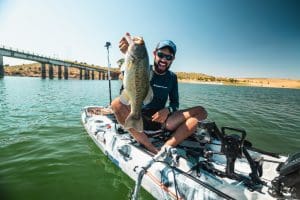
The Allure of Squid Fishing.
For a unique experience, consider the allure of squid fishing. Squid are abundant in certain seasons, and their preparation adds a touch of excitement to your culinary adventures. Discover curiosities about squid preparation as you integrate this fascinating aspect into your kayak fishing excursions.
Fishing in Spring.
As spring breathes new life into nature, it’s also a time of renewal for fish. They become more active, preparing for spawning. Head to shallower areas, especially near shorelines and structures, to capitalize on this increased activity. Experiment with different bait to entice bites.
Summer Strategies.
As temperatures rise, fish seek cooler depths in summer. Adjust your tactics by exploring deeper waters. Focus on drop-offs, underwater structures, and areas with adequate oxygen levels. Be patient, as fish may take longer to bite in warmer conditions.
Fall Feeding Frenzy.
Fall is a feeding frenzy for fish as they stock up for the upcoming winter. Target areas with abundant prey, such as baitfish schools. Use lures mimicking the local forage to attract bites. It’s a season of abundance, offering exciting opportunities for kayak anglers.
Winter’s Quiet Quest.
While winter may seem quiet, it’s an opportunity to explore deeper waters where fish seek warmth. Slow down your presentation, as fish are less active. Target areas with slow currents and structures that provide shelter. Winter kayak fishing requires patience but can yield rewarding catches.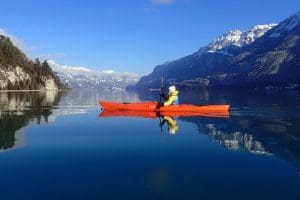
Exploring Key Questions about Kayak Fishing for Beginners.🐟
What are the best fishing spots for kayak fishing?
As a beginner in kayak fishing, the choice of location is crucial for a successful experience. Look for freshwater areas such as lakes, calm rivers, or reservoirs, ideal for learning the ropes. Coastal areas also offer exciting opportunities, but start in calmer waters before venturing into the ocean. Research and choose places with easy access that allow for a gradual learning experience.
How to choose the right kayak for fishing?
Selecting the right kayak is an essential step. Opt for a stable and spacious kayak for added comfort. Models designed specifically for fishing often come with storage compartments for equipment and mounting systems for accessories. Consider the length and carrying capacity, ensuring you have space for your catches. Before purchasing, if possible, test various models to find the one that best suits your needs.
Tips for staying safe while kayak fishing?
Safety is the number one priority in kayak fishing. Always wear a snug and approved life jacket. Before heading out, check the weather conditions and avoid days with excessive wind or storms. Practice re-entering the kayak in controlled waters to be prepared for possible capsizing. Stay close to the shore and share your plans with someone on land. Additionally, carry a communication device for emergencies.

